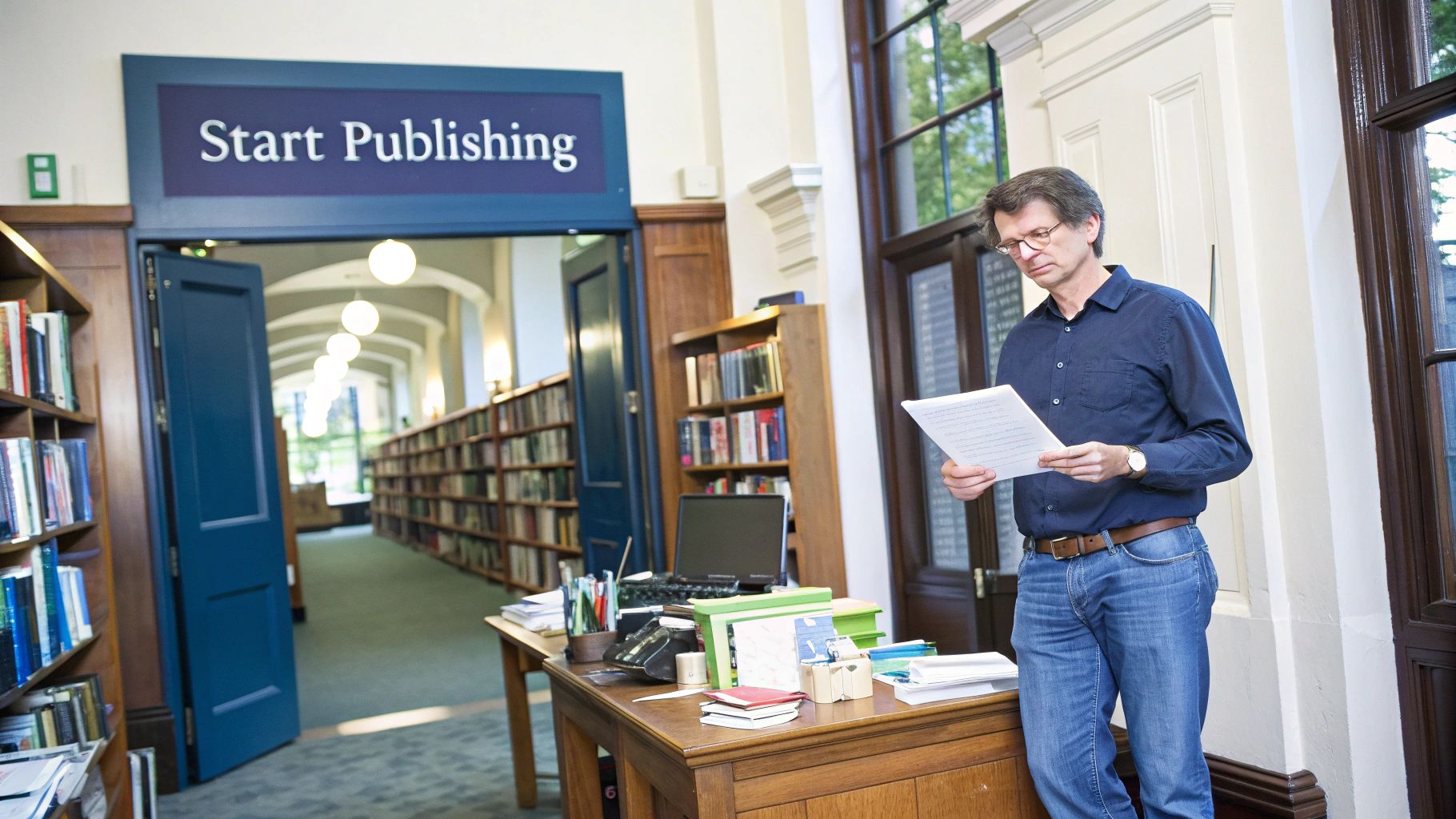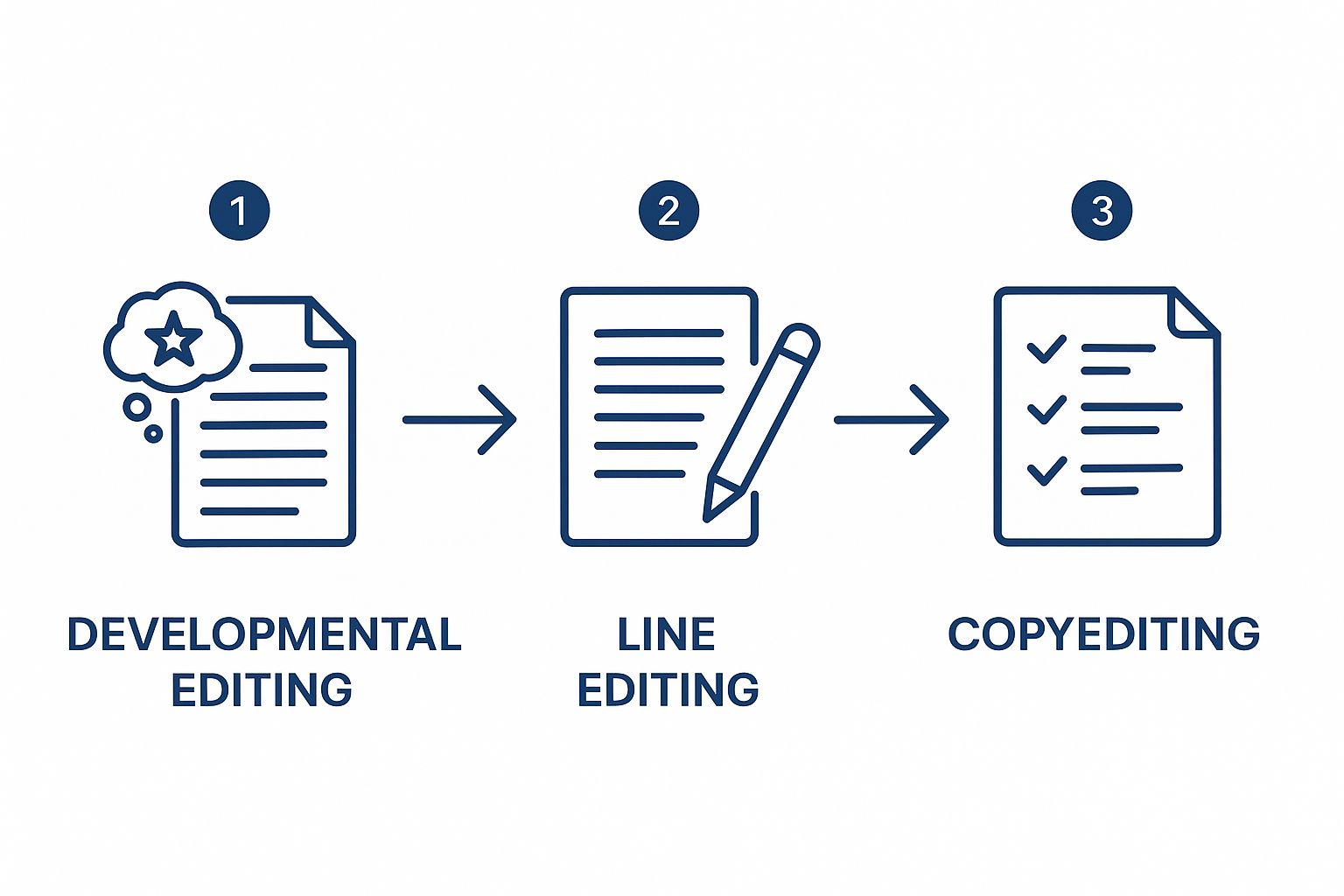So, you've written a book. That's a huge accomplishment, but now comes the big question: how do you get it into the hands of readers? Essentially, you're looking at two main roads: finding a traditional publisher or taking the reins and self-publishing.
Either way, you'll need a polished manuscript, an eye-catching cover, and a smart plan to tell the world about it. The real difference comes down to who foots the bill and who's in charge of the project—the publishing house or you.
Your Publishing Journey Starts Now

There's nothing quite like holding the finished, printed copy of your book. But let's be honest, the journey to that moment can feel like navigating a maze. This guide is your map. We'll break down every step, giving you a clear, practical roadmap whether you're aiming for a deal with a major publisher or embracing the independence of self-publishing.
The publishing industry isn't what it used to be, and that's great news for authors. New avenues are opening up all the time, giving you more direct ways to find and engage with your audience. We'll dig into these modern options, giving you the real-world know-how to start with confidence and a solid plan for success.
Navigating the Two Main Publishing Routes
The very first choice you'll make is a big one, and it shapes everything that comes next. Both traditional and self-publishing have their own sets of pros and cons. The best fit for you really depends on your personal goals, your budget, and how quickly you want to see your book in the world.
-
Traditional Publishing: This is the classic path. You find a literary agent, they pitch your manuscript to publishing houses, and hopefully, an editor makes an offer. The publisher pays for everything—editing, design, printing, distribution—and usually gives you an advance against future royalties. The catch? You give up some creative control, and the process is slow. It can easily take 18-24 months from signing a contract to your book hitting the shelves.
-
Self-Publishing: With this option, you are the publisher. You call all the shots, keep all the creative control, and earn a much bigger slice of the royalties. The timeline is also entirely up to you. The trade-off is that you cover all the upfront costs for editing, cover design, formatting, and marketing yourself.
If you're leaning toward the traditional route, a crucial first step is mastering the art of writing effective inquiry letters to get your foot in the door with agents and publishers.
No matter which path you choose, the fundamentals of a successful book don't change. You need a fantastic manuscript, a professional look, and a clear strategy for reaching readers. This guide will walk you through managing each of those pieces like a pro.
Preparing Your Manuscript for a Professional Launch
Alright, you’ve finished your manuscript. That’s a huge accomplishment, but it's also where the real work of publishing begins. Before you can even think about getting your book into readers' hands, you have to transform that draft into a polished, professional product.
This is the stage that separates the amateurs from the pros. A lot of first-time authors stumble here, thinking a quick spell-check is enough. It’s not. To compete, your book needs to be impeccable, and that starts with professional editing.
The Different Layers of Professional Editing
Think of editing not as a single task, but as a series of crucial passes, each one refining your work on a different level. It’s a process that moves from the big-picture story down to the tiniest details, like a misplaced comma.
This journey from rough draft to finished product follows a pretty standard path in the industry. Here’s a quick visual breakdown of how it usually flows.

As you can see, you start with the skeleton—the structure and story—before moving on to the muscle and skin of the language, and finally, a last check to catch any tiny blemishes.
Developmental Editing: Shaping Your Story
The first and most critical pass is developmental editing. This is all about the "big picture." A developmental editor isn't looking for typos; they're digging into the very foundation of your book.
For a fiction author, this means tackling the core elements:
- Plot and Pacing: Are there plot holes big enough to drive a truck through? Does the middle of your story drag?
- Character Arcs: Do your characters feel real? Do they change and grow in a way that makes sense?
- Structure and Theme: Does the narrative hold together, and does it leave a lasting impact?
If you've written non-fiction, the editor will scrutinize your argument, the flow of your chapters, and whether your message is clear and compelling for your intended audience. This is where you make sure your book actually works.
Line Editing and Copyediting: Honing Your Voice
Once the structure is solid, you zoom in on the sentences themselves with line editing and copyediting. People often lump these together, but they’re two distinct—and equally important—jobs.
Line editing is about the art of the sentence. A line editor focuses on your style, rhythm, and flow. They’ll help you eliminate awkward phrasing, cut out clichés, and make sure your unique authorial voice shines through on every page.
Copyediting is the technical part. A copyeditor is your grammar guru, meticulously checking for mistakes in:
- Grammar and spelling
- Punctuation
- Consistency (like making sure a character's name is spelled the same way in Chapter 2 and Chapter 20)
This step is non-negotiable. A handful of errors can shatter a reader's immersion and make your book look amateurish. Finding the right editor is a big decision, and we’ve put together a resource to help you figure out how to find a book editor who truly gets your project.
Key Takeaway: Developmental editing fixes the story. Line editing sharpens the prose. Copyediting eliminates errors. Each stage is essential for producing a high-quality book that can succeed in a competitive market.
The Final Polish: Proofreading
After every other edit is done and the book has been designed and laid out, it’s time for one last look: proofreading. This is the final line of defense. A proofreader’s job is to catch any tiny typos or formatting glitches that slipped through the cracks.
Don’t skip this. You want readers to get lost in your world, not pulled out of it by a stray error on page 157. A clean, professionally edited manuscript shows you respect your story and your readers.
And it matters. The appetite for great stories is growing worldwide. In fact, fiction sales have grown in 16 out of 18 global territories, while non-fiction only grew in six. This is especially true in Spanish-speaking markets and on digital platforms, where certain genres are seeing explosive growth. A polished book is your ticket to being part of that success.
Choosing Your Path: Traditional vs. Self-Publishing
https://www.youtube.com/embed/95w7isCQK3A
So, your manuscript is finally done. You've poured your heart and soul into it, and now you’re standing at the biggest fork in the road for any author. This is where you decide how your book will meet the world: through the gates of traditional publishing or by paving your own way with self-publishing.
There’s no magic answer here. The best path is the one that aligns with your specific goals, your budget, and frankly, your personality. Are you looking for the prestige and backing of a big New York house, or does the thought of total creative freedom and a faster timeline get you excited? Let's unpack what each journey really looks like.
The Traditional Publishing Route
This is the classic dream for many writers. You land a literary agent, they champion your manuscript, and a publishing house offers you a book deal. It’s a huge validation. If you get that deal, the publisher foots the bill for everything—professional editing, cover design, printing, distribution, and even a marketing push.
Sounds great, right? It can be. But it comes with some serious trade-offs. The timeline is notoriously slow; it can easily take 18 to 24 months from signing the contract to actually holding your book. You also give up a lot of control. The publisher gets the final say on the title, the cover art, and even edits to your text.
And the competition is fierce. Agents are flooded with submissions and can only take on a tiny fraction of the authors who query them. Rejection is a big part of this game.
The Self-Publishing Revolution
Not too long ago, self-publishing was seen as the option for books that "couldn't make it." Not anymore. Today, it’s a vibrant, legitimate, and often highly profitable path for authors who want to take charge.
When you self-publish, you’re the boss. Period. You have 100% creative control, from the first word to the final cover. You set your own schedule, hiring the editors and designers you want to work with.
The financial upside can be massive, too. Instead of the standard 10-15% royalty from a traditional publisher, you can earn up to 70% on platforms like Amazon KDP. Plus, you can go from a finished manuscript to a published book in a matter of weeks, not years.
The catch? You’re not just the author; you’re the entrepreneur. You fund the entire project yourself and are responsible for every single step, including the marketing hustle required to find your readers.
The Core Difference: In traditional publishing, you are selling your manuscript to a company. In self-publishing, you are building a business around your book. Each requires a different mindset and skill set.
Traditional vs. Self-Publishing: A Head-to-Head Comparison
Choosing your publishing path is one of the most critical decisions you'll make as an author. To help you see the differences more clearly, we’ve put together a direct comparison of the key aspects of each route.
| Aspect | Traditional Publishing | Self-Publishing |
|---|---|---|
| Creative Control | Low. Publisher has the final say on cover, title, and edits. | High. Author has 100% control over all creative decisions. |
| Upfront Cost | None. Publisher pays for all production and marketing. | Author funds everything: editing, design, marketing, etc. |
| Timeline | Slow. Typically 18-24 months from contract to launch. | Fast. Can publish in a matter of weeks or months. |
| Royalties | Lower. Averages 10-15% on hardcover, less on paperback/ebook. | Higher. Often 40-70%, depending on the platform and price. |
| Distribution | Broad. Strong access to physical bookstores and libraries. | Primarily online, though print-on-demand is expanding reach. |
| Validation | High. The "stamp of approval" from an established publisher. | Comes from sales, reviews, and building a direct reader base. |
| Marketing | Publisher has a dedicated team, but focus is often on lead titles. | Author is 100% responsible for all marketing efforts. |
Ultimately, both paths can lead to success, but they demand different things from you. This table should help you weigh what matters most for your book and your career.
Making an Informed Decision
So, how do you choose? It really comes down to an honest self-assessment. Neither route is "better"—one is just a better fit for you.
Think about these key questions:
- Control: How non-negotiable is your vision for the book's cover, title, and final text? If you need to have the final word, self-publishing is your corner.
- Timeline: Is your book on a timely topic, or are you simply not willing to wait two years to see it published? Speed is self-publishing's biggest advantage.
- Investment: Do you have the capital to invest in a professional team for editing, design, and marketing? If not, the no-upfront-cost model of traditional publishing might be necessary.
- Validation: How much does the idea of being "chosen" by a legacy publisher mean to you? For some, that external validation is the dream itself.
This is a huge decision, and it’s worth taking your time to get it right. For an even more detailed breakdown, our guide comparing traditional vs. self-publishing explores the financial and creative realities in greater depth. Getting this choice right lays the entire foundation for your book’s launch and your long-term satisfaction as an author.
Designing and Producing a Professional Book

You’ve made it through the marathon of editing, and now for the really exciting part. This is where your manuscript finally sheds its identity as a Word doc and begins to look and feel like a real book. A powerful story deserves a package to match, and this stage is all about nailing the visual and technical details that make a book irresistible to readers.
I’ve seen it time and again: authors pour their souls into the writing but then treat the design as an afterthought. That’s a huge mistake. Your book’s cover is its single most important marketing asset, and the interior layout is what keeps a reader comfortably immersed in your world. Getting these right isn’t just a nice-to-have; it's essential for your book's success.
The Psychology of a Compelling Book Cover
Let's be honest—we all judge books by their covers. It’s the first handshake with a potential reader, happening in a split second on a crowded Amazon page or a bookstore shelf. A great cover isn’t just about pretty art; it’s a masterclass in silent communication, instantly telling someone the book's genre, tone, and who it's for.
Think about it. A thriller cover often uses deep shadows, high-contrast colors, and sharp, urgent fonts to scream "suspense." A romance novel, by contrast, might lean on softer palettes, elegant scripts, and imagery that hints at connection. It’s a visual shorthand that readers instinctively understand.
Your cover makes a promise. It sets an expectation for the experience waiting inside. A professional, genre-appropriate design signals that the story itself is just as polished and will deliver on that promise.
Interior Layout and Typesetting for Readability
Once that amazing cover has convinced someone to take a chance, the interior design has to carry the torch. This is where professional typesetting comes in. It’s the subtle art of arranging text on a page to make it a joy to read. If you’ve ever put down a book because the text felt cramped or the font was just… weird, you’ve experienced the pain of bad typesetting.
The whole point is to make the design disappear, so the reader forgets they're even looking at a page and just falls into the story. This involves careful, deliberate choices:
- Font Selection: We almost always use a classic serif font like Garamond for the main text because those little "feet" on the letters guide the eye smoothly across the page, reducing fatigue. For headings, a clean sans-serif font often provides a nice contrast.
- Margins and Spacing: Ample white space is your friend! It keeps the page from feeling cluttered and gives the reader's eyes a place to rest.
- Chapter Headings: The design of your chapter titles and first pages should be consistent and reflect the book's overall personality.
You know you have good interior design when you don't notice it at all. This is true for both print and ebooks, though the technical execution is completely different for each format.
Handling the Technical Necessities
Beyond the creative side of design, there are a few technical hurdles to clear to officially turn your manuscript into a book that can be sold. These are the non-negotiables of the publishing world.
First up: International Standard Book Numbers (ISBNs). Think of an ISBN as your book’s unique social security number. This 13-digit code is how booksellers, distributors, and libraries track and order your book. You absolutely need a separate ISBN for each format—one for the paperback, another for the hardcover, a third for the ebook, and so on.
Next is copyright registration. Legally, your work is copyrighted the moment you create it, but formally registering it with the U.S. Copyright Office creates a public record of your ownership. This is your best legal defense if you ever need to protect your work from infringement.
Finally, for any print versions, you’ll need to make some decisions about the physical book itself.
- Trim Size: This is simply the physical dimension of the book. A typical novel is often 6"x9", while a shorter nonfiction book might be 5.5"x8.5".
- Paper Quality: You'll choose the weight and color (usually cream or white) of the interior paper. Cream is easier on the eyes and often feels more "literary," while white is great for books with images.
- Binding: The most common options are paperback (what we call "perfect bound") or a more durable and expensive hardcover.
Every one of these choices adds up to create the final, tangible product that someone will hold in their hands. Taking care with these details ensures your book looks every bit as professional as the story inside.
Marketing Your Book and Finding Your Readers

You did it. You poured your heart and soul into writing a book. But as monumental as that was, the next phase is just as critical: getting that book into the hands of people who will love it.
This is where marketing and distribution take center stage. After all, even the most brilliant story is just a file on a hard drive until readers know it exists. Building a genuine, thoughtful plan to connect with your audience isn't an afterthought—it's the other half of the author's journey.
First things first, let's talk about how your book will actually get to people. Distribution is the nuts and bolts of making your book available to buy, and these days, you have options.
- Print-on-Demand (POD): This is a game-changer for many authors. A book is printed only when a customer clicks "buy." There's no garage full of unsold copies and no massive upfront printing bill. It's a low-risk, flexible path offered by services like Amazon KDP and IngramSpark.
- Traditional Print Runs: Here, you print a large batch of books at once. The cost per book is much lower, which is great for your profit margins. This is the model traditional publishers use, and it's essential if you want to see your book stocked on the shelves of most physical bookstores.
Build Your Home Base: The Author Platform
Once you know how people can buy your book, you have to give them a reason to find it. You can't just publish and pray. You need to build pathways that lead readers directly to you. In the publishing world, we call this your author platform.
Think of your author platform as your own little corner of the internet—a place where you can connect directly with readers and build a community. It's the foundation for everything else you'll do to promote your book.
The cornerstone of this platform is a professional author website. It doesn't need to be complicated, but it should look clean, be easy to navigate, and showcase your book. This is also the perfect place for a blog, your author bio, and—most importantly—your email signup form.
Seriously, don't sleep on email. Learning how to build an engaged email list is one of the most valuable things you can do. Unlike a social media following, which can disappear overnight with an algorithm change, your email list is yours. It's a direct line to your most dedicated readers.
Your Roadmap to Reaching Readers
Marketing a book doesn’t have to feel like you're a pushy salesperson. At its best, it’s about authentic connection—finding the very people who are searching for a story just like yours and letting them know it exists. A solid marketing plan is your roadmap for making that happen.
It all starts with knowing who you're talking to. Who is your ideal reader? What other authors do they binge-read? Where do they spend their time online? Answering these questions helps you stop shouting into the void and start having meaningful conversations.
With your reader in mind, you can pick your tools:
- Be Smart with Social Media: Don't burn yourself out trying to be on every platform. If you wrote a business book, LinkedIn is probably your jam. If you penned a YA romance, you'll find your people on TikTok and Instagram. Go where your readers are.
- Chase Those Early Reviews: Nothing sells a book like social proof. Getting early reviews from book bloggers, your street team, or services like NetGalley builds incredible momentum for launch day and beyond.
- Use Targeted Ads Wisely: Once you have a handful of good reviews, platforms like Amazon Ads or Facebook Ads can be incredibly effective. They let you put your book cover right in front of people who are already reading books in your genre.
Think of marketing not as selling a product, but as inviting readers into the world you created. The more you focus on genuine connection, the more effective—and enjoyable—it becomes.
For a much deeper dive into creating a strategy that fits your specific genre and goals, take a look at our complete guide to building a https://barkerbooks.com/book-marketing-plan/.
The global book market is huge and still growing—it’s projected to reach $156.04 billion by 2030. That number tells us one thing: for nearly every niche and genre, there is an audience waiting. Your job is simply to build the bridge that connects your book to them. This growth is an incredible opportunity for authors who are ready to not only publish their work but actively help it find a home.
Got Questions? We’ve Got Answers.
The road to publishing is paved with new lingo, big decisions, and a whole lot of "what ifs." Feeling a bit lost in the weeds is completely normal—we've seen it thousands of times. After guiding countless authors from a simple Word doc to a published book, we've heard just about every question you can imagine.
Think of this as your personal cheat sheet. We're here to give you the straight scoop on the questions that come up most often, helping you trade uncertainty for confidence.
What’s the Real Deal with a Book Advance?
The advance is one of those terms everyone’s heard of but few truly understand. Simply put, it's a lump sum a publisher pays you upfront for the right to sell your book. But here’s the critical part: it’s paid against your future royalties.
This means you won’t see another penny from sales until your book has earned back the full amount of that advance. Let’s say you get a $10,000 advance. Your book has to generate more than $10,000 in your share of the royalties before you start receiving those quarterly checks. This is what the industry calls "earning out."
Advances can be anything from a modest few thousand dollars to a life-changing six-figure deal. At its core, the size of an advance is the publisher's bet on your book's potential success.
Do I Actually Need a Literary Agent?
This is a big one, and the answer really depends on your destination. If you're aiming for a traditional publishing deal with one of the big houses, then the answer is almost always a resounding yes.
The vast majority of major publishers and their imprints have a strict "no unsolicited manuscripts" policy. Your manuscript will likely be ignored unless it comes through a recognized literary agent.
But an agent is so much more than a key to the door. They're your champion, your negotiator, and your career strategist.
- Who they know: Agents have personal relationships with editors across the industry, so they know exactly who to pitch your book to.
- The art of the deal: They fight to get you the best possible contract, from a higher advance to more favorable royalty rates.
- Your career partner: A good agent provides guidance long after the ink on the contract is dry.
On the other hand, if you’re self-publishing, you don't need an agent. You're in the driver's seat, managing the entire process yourself or with a trusted partner like BarkerBooks.
How Long Is This Whole Publishing Thing Going to Take?
Patience is a virtue, especially in publishing. The timeline can swing wildly depending on which path you take, so it's crucial to set your expectations.
| Publishing Path | Typical Timeline | What's Happening Behind the Scenes |
|---|---|---|
| Traditional Publishing | 18 – 24 months (sometimes longer!) | This long runway accounts for finding an agent, publisher submissions, multiple rounds of editing, cover design, printing, and a long lead time for marketing and sales teams to pitch to retailers. |
| Self-Publishing | A few weeks to a few months | You set the pace. The timeline depends entirely on how quickly you can finalize your manuscript, editing, and design. |
The traditional route is slow by design. That extended timeline gives them the space for deep editorial development and allows their sales force to secure orders from bookstores. Self-publishing’s speed, however, offers incredible freedom, particularly if you're writing in a fast-moving genre or want to release books quickly.
The Bottom Line: Your choice is a trade-off. Traditional publishing might offer prestige and no upfront costs, but you give up control and have to be incredibly patient. Self-publishing gives you total ownership and speed-to-market, but it requires an investment and an entrepreneurial mindset.
Can I Really Get My Book into Physical Bookstores?
Walking into a Barnes & Noble and seeing your book on the shelf is the ultimate dream for many authors. It's absolutely possible, but how you get there is completely different for each publishing path.
With a traditional publisher, bookstore distribution is part of the deal. Their sales reps have established relationships with book buyers at all the major chains and indie stores. They’re pitching your book for shelf space months before it ever hits the press.
For self-published authors, it’s a tougher climb, but far from impossible. Using a print-on-demand service like IngramSpark makes your book available for any bookstore in the world to order. The trick is getting them to actually place that order. This usually takes direct outreach, building a strong local buzz, or having a proven track record of online sales. A great first step is often to partner with local independent bookstores in your area.
Despite all the changes in the industry, the book market is still incredibly strong. In the U.S. alone, the book publishing industry's revenue is projected to hit $27.59 billion by 2030. That stability, fueled by the explosive growth of audiobooks and e-books, proves it's a healthy and exciting time to become an author. You can dig into more of the data in these book industry projections on IBISWorld.com.
Navigating the publishing world can feel like a maze, but you don't have to find your way alone. BarkerBooks is here to guide you every step of the way, from a polished manuscript to global distribution. Ready to publish your book with a team of experts in your corner? Explore our publishing packages at BarkerBooks today.
